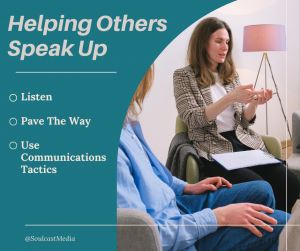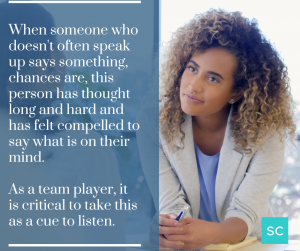Helping Others Speak Up
When we think about our family or friends, we naturally advocate for them because we genuinely care about their well-being. We want to see them thrive. Similarly, in the workplace, whether we belong to an underrepresented group or not, it’s important for all of us to play a role in helping others build their confidence in communication. Embracing diversity and empowering others benefits everyone involved.
People notice when we work to uplift others.
According to a recent study, employees are 17% more satisfied with their job when they engage in collaboration at work. This collaboration is dependent upon ensuring everyone’s voices can be heard.
Below are three ways we can work to help others on our teams speak up with confidence.
1. Tremendous Listener
When someone who typically doesn’t speak up decides to share their thoughts, it’s important for us, as team players, to recognize the significance of their contribution. It’s likely that this individual has taken the time to carefully consider their words and has felt compelled to speak up. In such moments, it becomes crucial for us to take this as a cue to listen attentively.
Consider the following:
- Why Now? – When a colleague or team member who is typically reserved decides to speak up, it’s important for us to be attentive and ask ourselves why they are choosing to do so. Being a great listener requires paying attention not only to what is said but also to the context surrounding their contribution. For instance, let’s imagine we are in a meeting, and a usually quiet colleague speaks up regarding the project deadline. In this situation, we have a couple of choices. We can either dismiss their concerns or take a moment to reflect and inquire why they are speaking up about it now. By choosing to delve deeper and understand their perspective, we demonstrate respect and active listening.
- What Are They Trying To Say? – Another important question we should ask ourselves is, “What are they really trying to say?” When a colleague speaks up about a specific issue, it’s essential to go beyond the surface level and try to understand the underlying message. For instance, if our colleague expresses difficulties in working with a particular client and it appears to be directed at them personally rather than the whole group, we have two choices. We could dismiss their concerns as their own problem, attributing it solely to their individual experience. However, a more empathetic and inclusive approach would be to dig deeper and truly listen to what they are trying to communicate.
- Don’t Jump In – Being a good listener involves refraining from jumping in before someone has finished expressing their thoughts. It’s important to exercise patience and allow others the space to fully articulate their ideas. For instance, let’s consider a situation where our colleague is discussing an issue and we happen to have a solution in mind. Instead of interrupting and cutting them off, it’s crucial to wait until they have finished speaking. Interrupting someone not only disrupts their train of thought but also sends a message that we may not genuinely care about what they have to say. It can make them feel undervalued or unheard, potentially discouraging them from speaking up in the future. By interrupting, we unintentionally undermine the trust and open communication that are essential for a psychologically safe speaking environment.
Being tremendous listeners involves creating space for those who don’t frequently speak up to share their thoughts and complete their ideas. It’s an essential aspect of fostering inclusivity and ensuring that everyone’s perspectives are considered. By doing so, we enable individuals to fully process what has been said and contribute their unique insights.
2. Pave The Way
As individuals in managerial roles, it’s crucial for us to take the lead in paving the way for more dialogue within our teams. Paving the way involves creating an environment where open and honest communication is not only encouraged but also actively supported. It means removing obstacles and ensuring that others feel comfortable sharing what’s on their minds.
Consider the following:
- Be The Example – As leaders, it’s our responsibility to create an environment where every team member feels comfortable and empowered to share their thoughts and ideas. One crucial way to achieve this is by setting an example through our own behavior. By being mindful of how we communicate and actively listening, we can pave the way for effective dialogue within the team.

- Body Language – Paying attention to body language cues from our underrepresented colleagues and team members is essential in creating an environment where they feel comfortable and empowered to speak up. Often, nonverbal cues can provide valuable insights into someone’s readiness or desire to contribute. By being attentive to these cues, we can help pave the way for underrepresented groups to have their voices heard.
- Give Them The Floor – Another effective way to pave the way for our underrepresented colleagues to share their ideas is by actively giving them the floor and highlighting their contributions. When we notice that a colleague has an excellent idea but may be hesitant to bring it up in a meeting, we can play a supportive role in ensuring their voice is heard.
When we utilize our voices to speak up and advocate for our underrepresented colleagues, we create valuable opportunities for them to share their thoughts and ideas. By using our influence and platform, we can help pave the way for their voices to be heard.
3. Communications Tactics
There are several specific communication tactics we can employ to encourage others to speak up, both with our colleagues and within our teams. These tactics create an inclusive and supportive environment where everyone feels empowered to contribute.
Consider the following:
- Acknowledging – One of the most crucial communication tactics, especially when it comes to our underrepresented team members and colleagues, is to acknowledge and validate what they’ve said. By doing so, we demonstrate that we genuinely care and are actively listening to their contributions. Acknowledging their contribution serves multiple purposes. It shows our underrepresented team members that their voices matter and their ideas are valued. This affirmation can boost their confidence and encourage them to continue speaking up. It signals to the rest of the team that all contributions are important and worthy of recognition, fostering a culture of inclusivity and respect.

- Specific Phrases – We can employ various specific phrases to create a supportive environment where our underrepresented colleagues and team members feel comfortable speaking up. These phrases not only encourage their participation but also validate their contributions. Phrases like, “That’s an interesting point” or “What you’re saying is.” Using these phrases and similar expressions helps create an inclusive and supportive environment where all voices are heard and respected.
- Reassurance – Offering reassurance is a powerful tactic when it comes to helping others, especially those who may be hesitant to speak up, feel valued and heard. By using words that make them feel acknowledged and appreciated, we demonstrate our care and support. If we notice a colleague, such as Fred, who seems unsure about sharing their ideas, we can offer reassurance to boost their confidence. We can say something like, “Fred, your idea is excellent. I genuinely believe our team would benefit from hearing what you have to say. Please feel free to share your thoughts.” This kind of affirmation validates their contributions and encourages them to overcome their hesitation.
Using words of reassurance in both scenarios helps create an environment where individuals feel seen, valued, and encouraged to speak up. It fosters a culture of support and empowers everyone to contribute their ideas openly.
Creating equal communication among all individuals is crucial in fostering an inclusive and collaborative environment. To achieve this goal, we can employ three key strategies: active listening, paving the way for more dialogue, and utilizing effective communication tactics.
__
Whenever you’re ready, there are 3 ways we can help you:
- Discover your communications style so you know where to start. Over 4,000 people have found theirs here.
- Attend our monthly communication workshop to build communications confidence (new topics: public speaking, advocating for yourself, building credibility, etc) here.
- Get your brand in front of 43k+ people by sponsoring our newsletter or Soulcast Media | LIVE LinkedIn events [contact: hello@soulcastmedia.com]











